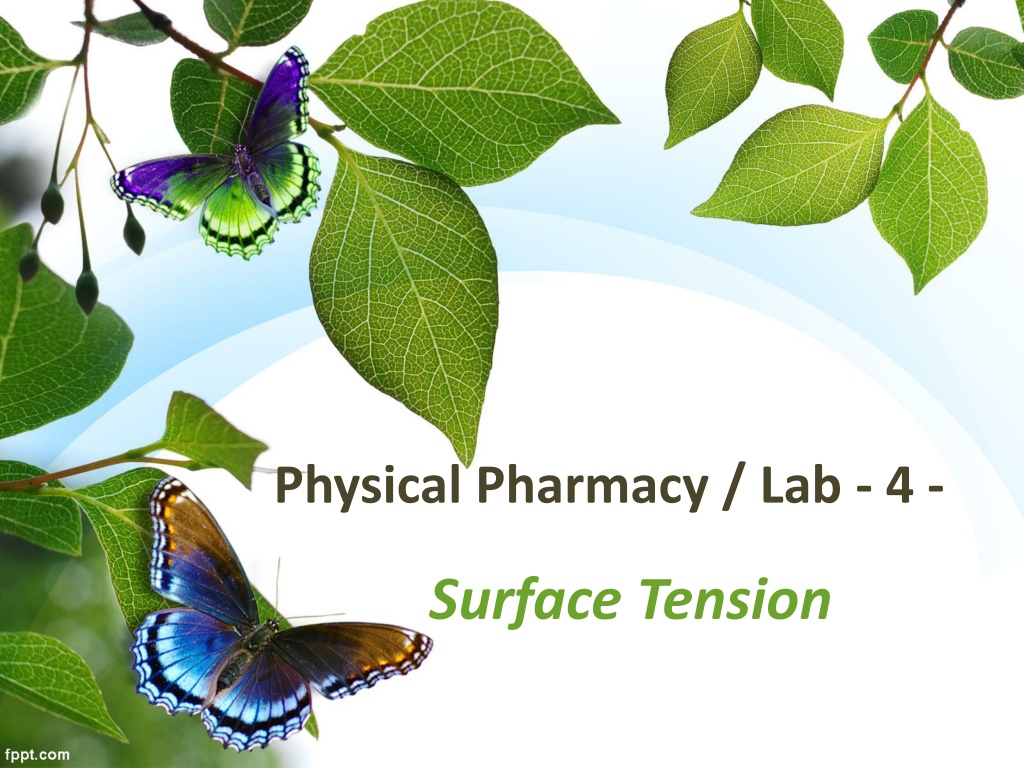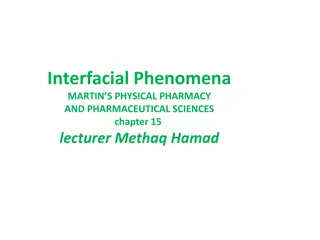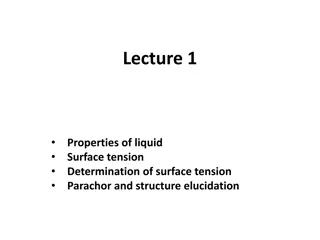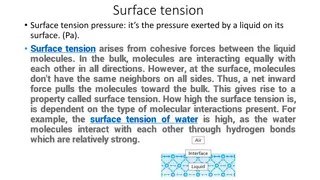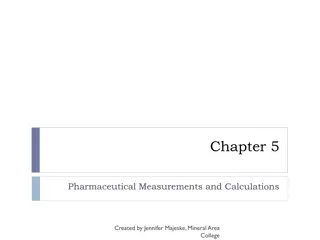Understanding Surface Tension in Physical Pharmacy Lab
Surface tension is a crucial concept in physical pharmacy lab dealing with gas-solid or gas-liquid interfaces. It refers to the force per unit length required to balance the inward pull on the surface. Interfacial tension, cohesive forces, and adhesive forces play significant roles in determining surface tension. Factors impacting surface tension include temperature and the presence of surface-active agents like surfactants. By understanding these principles, we can manipulate surface tension for various applications.
Download Presentation

Please find below an Image/Link to download the presentation.
The content on the website is provided AS IS for your information and personal use only. It may not be sold, licensed, or shared on other websites without obtaining consent from the author. Download presentation by click this link. If you encounter any issues during the download, it is possible that the publisher has removed the file from their server.
E N D
Presentation Transcript
Physical Pharmacy / Lab - 4 - Surface Tension
surface is used when referring to either a gas-solid or a gas-liquid interface. The tension in the surface: is the force per unit length that must be applied to the surface so as to counterbalance the net inward pull. It has the units of dyne/cm. as shown in Figure 1.
Interfacial tension: is the force per unit length existing at the interface between two immiscible liquid phases and has the unit of dynes/cm. ordinarily; it is less than surface tension because the adhesive forces between liquid phases forming an interface are greater than when a liquid and a gas phase exist together. It follows that if two liquids are completely miscible; no interfacial tension exists between them.
Furthermore, there are two important terms related to forces. First, Cohesive forces are the intermolecular forces which cause a tendency in liquids to resist separation. These attractive forces exist between molecules of the same substance. While, Second, adhesive forces are the attractive forces between unlike molecules. They are caused by forces acting between two substances, such as mechanical forces (sticking together) and electrostatic forces (attraction due to opposing charges)
Factors affecting surface tension 1. Temperature 2. Surface active agents(S.A.A): addition of surfactants to water decreases the surface tension. Because surfactants in water orient themselves at interface in such away to remove hydrophobic tail away from aqueous phase, as a result some of water molecules at the interface replaced by non-polar part of surfactant and since attractive force between surfactant molecules (cohesive force) & between S.A.A and water (adhesive force) less than cohesive force between water molecules a lone (i.e. decrease cohesive force leads to decrease net effect (cohesive- adhesive) leads to decrease surface tension).
Methods to measure surface tension There are several methods of surface tension measurements: 1. Drop weight method: The surface tension of the liquid is related to the weight of a drop of that liquid which falls freely from the end of the tube by the expression = surface tension (gm.cm/sec = dyne /cm) M=mass of one drop, R= radius, F= correction factor G= 980 cm/sec or 9.8 m/sec
Procedure 1- Check that the glass tip is very clean & free from any defect particularly around the edges 2-Allow the drop (e.g. water) to detach slowly from the tip & collect 10 -15 drops in a beaker under constant conditions (constant temperature). 3-Finally, measure the radius of tip. It is important that the drop has been correctly formed & detached and the rate of detachment should not exceed 1 drop in 2 sec, & vibration must be guarded against as well as check the end of the tip is horizontal.
2. Modification of drop weight method (drop number method):- It may be performed by counting the numbers of drop (n) by certain volume (0.5 ml) under conditions similar to that prescribed previously. A comparison with liquid of known surface tension must be similarly treated by using the same tube under the same condition. Surface tension of water =72.8 at 25 c & d=1
3. Ring detachment method (Du Noy Ring Tensiometer): The principle of the instrument depend on the fact that the force necessary to detach a platinum ring immersed at the surface or interface is proportional to the surface or interfacial tension.
4- Capillary rise method:- In this method when inversed tube (capillary tube) in a liquid, the tube will be risen up to a certain distance by a liquid , it depends on: surface tension of liquid ( increasing surface tension leading to increase height of liquid) and on the cross section area of that tube ( increase area leads to increase height)for the cross section area at any point upward force resulting from the surface tension of the liquid on the circumference.
Experimental work The aim of the experiment is to determine the surface tension of liquids in addition to the C.M.C. of surfactant such as tween. Materials and equipment:- -Distilled water, alcohol, solution 2% tween60 -graduated pipette, weighing bottles , beaker , conical and volumetric flask( 50 cc).
Procedure: 1. Use modified drop method to measure the surface tension of the concentrations of tween60 (0.01%, 0.03 %, 0.05%, 0.075%, 0.1%, 0.2%), then prepare 50 ml of each solution by dilution method using 2% stock solution. 2. Plot surface tension versus concentration. 3. Determine C.M.C. of tween60 from the plot (n water=16) ( water =72.8). The densities of the concentration used are as follows:- Use water as a standard liquid (surface tension =72.8 & its density = 1).
